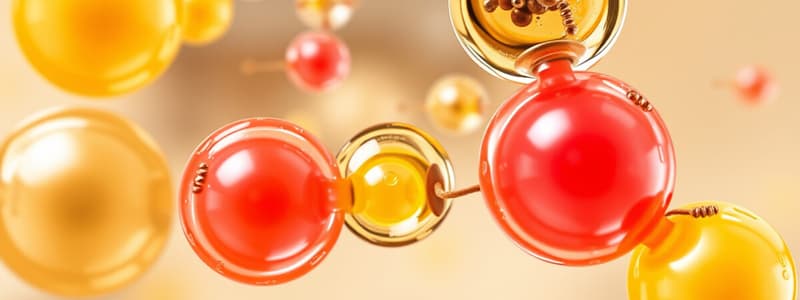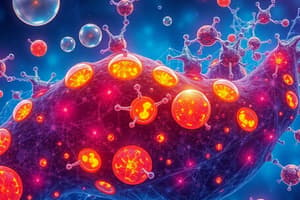Podcast
Questions and Answers
What do lipids constitute?
What do lipids constitute?
A heterogenous group of compounds of biochemical importance.
What is the solubility of lipids in water and non-polar solvents?
What is the solubility of lipids in water and non-polar solvents?
Relatively insoluble in water but freely soluble in non-polar solvents such as benzene, chloroform, ether, hot alcohol, and acetone.
What are fatty acids derived from?
What are fatty acids derived from?
Lipids.
What is hydrolysis of oils and fats?
What is hydrolysis of oils and fats?
What is the most common component of lipids?
What is the most common component of lipids?
What structure do fatty acids have?
What structure do fatty acids have?
Fatty acids are found in a free state in nature.
Fatty acids are found in a free state in nature.
Free fatty acids in humans are formed during metabolism.
Free fatty acids in humans are formed during metabolism.
What does COOH represent in fatty acids?
What does COOH represent in fatty acids?
What does the R group in fatty acids determine?
What does the R group in fatty acids determine?
How are triglycerides produced?
How are triglycerides produced?
Which fatty acids are the most abundant in the human body?
Which fatty acids are the most abundant in the human body?
What are acetic and butyric acid considered?
What are acetic and butyric acid considered?
Polyunsaturated fatty acids exhibit geometric isomerism.
Polyunsaturated fatty acids exhibit geometric isomerism.
How many double bonds does linoleic acid have?
How many double bonds does linoleic acid have?
Most unsaturated fatty acids are stable trans isomers.
Most unsaturated fatty acids are stable trans isomers.
Cis isomers of fatty acids bend.
Cis isomers of fatty acids bend.
Trans isomers of fatty acids do not bend.
Trans isomers of fatty acids do not bend.
Why are linoleic and linolenic acids considered essential fatty acids?
Why are linoleic and linolenic acids considered essential fatty acids?
How can the body synthesize oleic acid?
How can the body synthesize oleic acid?
From what can arachidonic acid be synthesized?
From what can arachidonic acid be synthesized?
What is the alpha carbon in fatty acids?
What is the alpha carbon in fatty acids?
What is the beta carbon in fatty acids?
What is the beta carbon in fatty acids?
What is the terminal methyl carbon referred to in fatty acids?
What is the terminal methyl carbon referred to in fatty acids?
How many carbon atoms do eicosanoids contain?
How many carbon atoms do eicosanoids contain?
What are eicosanoids?
What are eicosanoids?
From what are eicosanoids derived?
From what are eicosanoids derived?
Into how many groups are eicosanoids classified?
Into how many groups are eicosanoids classified?
All eicosanoids function locally at the site of synthesis.
All eicosanoids function locally at the site of synthesis.
What are the three sources of fatty acids?
What are the three sources of fatty acids?
What activates phospholipase A2?
What activates phospholipase A2?
What is the synthetic analogue of PGE1 used for?
What is the synthetic analogue of PGE1 used for?
Prostaglandin I opposes the action of thromboxane.
Prostaglandin I opposes the action of thromboxane.
What cell types synthesize leukotrienes?
What cell types synthesize leukotrienes?
In which processes are leukotrienes mainly seen?
In which processes are leukotrienes mainly seen?
What is the half-life of prostaglandin?
What is the half-life of prostaglandin?
Leukotrienes survive for some hours in tissue.
Leukotrienes survive for some hours in tissue.
What are leukotrienes responsible for in asthma?
What are leukotrienes responsible for in asthma?
What is Zileuton used for?
What is Zileuton used for?
What class do Montelukast and Zafirlukast belong to?
What class do Montelukast and Zafirlukast belong to?
Flashcards are hidden until you start studying
Study Notes
Lipids and Fatty Acids
- Lipids are a diverse group of compounds vital to biochemistry.
- They are hydrophobic, being insoluble in water but soluble in non-polar solvents like benzene and ether.
- Fatty acids are a primary component of lipids and are derived lipids.
- Hydrolysis involves reactions where ethanolic KOH interacts with oils to produce glycerol and fatty acids.
- Most fatty acids combine with glycerol to form triglycerides; they do not exist freely in nature.
Structure and Classification of Fatty Acids
- Each fatty acid has one carboxyl group and a non-polar hydrocarbon tail, contributing to their hydrophobic nature.
- The carboxyl group (COOH) is the functional group that defines chemical properties, while the hydrocarbon chain (R group) influences physical properties.
- Triglycerides are created through the esterification process between glycerol and fatty acids.
- Palmitic and stearic acids are the most prevalent fatty acids in the human body.
Essential Fatty Acids and Metabolism
- Acetic and butyric acids are key metabolic intermediates.
- Polyunsaturated fatty acids can exhibit geometric isomerism at double bonds.
- Linoleic acid contains two double bonds and is essential since humans cannot synthesize it.
- Most unsaturated fatty acids primarily exist as unstable cis isomers instead of stable trans isomers.
- Cis isomers are curved, whereas trans isomers remain straight.
Synthesis and Function of Fatty Acids
- Oleic acid can be synthesized from stearic acid, but humans cannot create linoleic or linolenic acids beyond the ninth carbon.
- Arachidonic acid can be synthesized from linoleic acid, which serves as a precursor for various eicosanoids.
- Eicosanoids are defined by having twenty carbon atoms and exhibit hormone-like actions locally where they are synthesized.
Eicosanoids and Their Role
- Eicosanoids are classified into two categories: prostanoids and leukotrienes.
- They function primarily at their synthesis sites, affecting local physiological processes.
- Three primary sources of fatty acids include dietary intake, essential fatty acids, and body synthesis.
- Activators of phospholipase A2 include histamine and cytokines.
Pharmacological Implications
- Misoprostol, a synthetic PGE1 analogue, is utilized to protect against gastric acid in patients using aspirin or NSAIDs.
- Prostaglandin I counteracts thromboxane actions.
- Leukotrienes are synthesized in various cell types and play significant roles in inflammatory responses, particularly in asthma and bronchitis.
- Prostaglandins have a short half-life of around five minutes, while leukotrienes can last for hours in tissues and contribute to prolonged bronchoconstriction in asthma.
- Zileuton, an inhibitor of 5-lipooxygenase, is used for treating ulcerative colitis.
- Montelukast and zafirlukast are leukotriene receptor antagonists that block leukotrienes' effects.
Studying That Suits You
Use AI to generate personalized quizzes and flashcards to suit your learning preferences.




